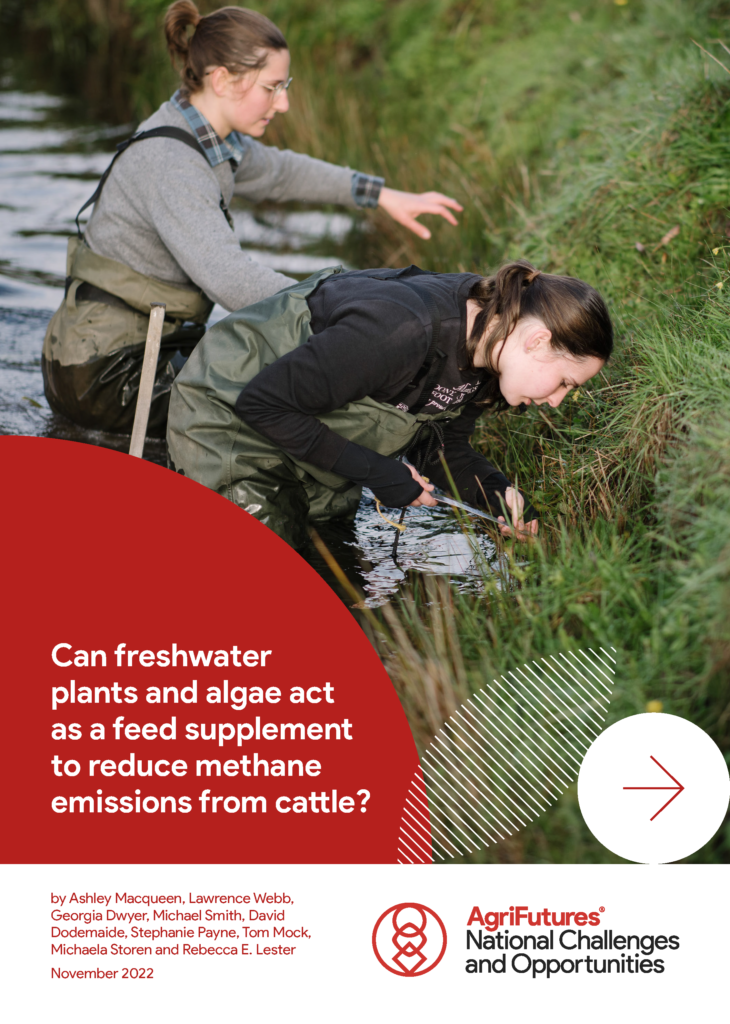Pathways to develop a future-ready workforce
Like the industries that AgriFutures Australia serves, the future workforce will likely be broad and diverse. For rural industries to be better prepared for the...
 NATIONAL CHALLENGES AND OPPORTUNITIES
NATIONAL CHALLENGES AND OPPORTUNITIES 
100 pages
Published: 2 Sep 2023
Author(s): Ashley Macqueen, Lawrence Webb, Georgia Dwyer, Michael Smith, David Dodemaide, Stephanie Payne, Tom Mock, Michaela Storen, Rebecca E. Lester
ISBN: 978-1-76053-417-2
Download report PDF
DownloadPurchase a hard copy - AUD $60
Methane production by livestock is a non-trivial component of Australia’s greenhouse gas emissions. Reducing these emissions will help reach Australia’s stated goal of a 43% emission reduction from 2005 levels, by 2030. Additionally, reducing emissions will also assist agricultural communities and businesses to reduce their impact, as many are committed to achieving.
The marine red algae, Asparagopsis taxiformis, has been identified as potent methane inhibitor. Methane production reduced by >90%, both in vitro and in vivo studies, however, to date A. taxiformis is unable to be produced at the scale required. Finding additional taxa with similar methanogenesis-inhibiting properties may provide multiple pathways for methane reduction. Evidence that these properties can be found in freshwater plants and algae is growing, however there are many knowledge gaps for candidate species in Australia.
This project aimed to provide foundational evidence of methanogenesis-inhibiting properties in Australian freshwater plant and algae. This proof-of-concept report includes a review of relevant methane reduction processes and plausible candidate species, sampling, in vitro testing of methanogenesis-inhibiting properties and chemical composition.
The literature review identified a number of candidate freshwater plant and algal species for further testing of methanogenesis-inhibiting properties. Where possible, candidate species were collected locally (Barwon River catchment) for further testing. Natural mixes of macroalgae were also collected, as they rarely grow in monoculture. Biochemical, lipid and DNA analysis was undertaken on the samples, in order to determine properties that may lead to methane reduction in freshwater plants and algae.
Biochemical analysis identified several flavonoids and polyphenolic compounds of interest. Polyphenols found in black tea have been shown to reduce methane production in sheep and flavonoids are known bioactive compounds. However, further research is needed to assess the significance of these compounds for anti-methanogenic properties. Proximate composition analysis indicated that the samples which lowered methane production in the in vitro trials also had elevated lipid concentrations. Therefore, fatty acid analysis was undertaken, showing a negative correlative effect of total omega-3 polyunsaturated fatty acids on methane production. Furthermore, both omega-3 and omega-6 polyunsaturated fatty acids such as α-linolenic acid (18:3n-3; ALA) and linoleic acid (18:2n-6; LA), respectively have been shown to reduce methane production in in vitro and in vivo trials and have known nutritional value to humans.
Following this, the most promising candidates were tested in vitro batch assay trials. They consisted of two single dose trials and one multiple dose trial to assess the capabilities of freshwater plant and algal species at reducing gas and methane reduction when fermented by rumen microbes in vitro. The first single dose trial showed Algal mix 1 (CB27) and Montia australasica (CB19) had the potential to reduce methane production by 15% and 7%, respectively. While in the second trial further two algal mixes (CB32 and CB35) also reduced methane by 12 and 11%, respectively. The multiple dose trail focused on the two promising samples from the first single dose trial, Algal mix 1 and M. australasica. At a 20 mg/100mg (or a 20%) dose, Algal mix 1 reduced methane production by 24% and M. australasica reduced methane production by 21% at a 50% dose.
DNA analysis was performed on multiple algal sample mixtures to identify possible species of interest. Spirogyra sp. was identified in multiple samples that displayed methane reduction capabilities during the in vitro trials and could be a possible candidate for future research. Mineral analysis of promising samples showed that all tested would be safe for inclusion as a feed additive at a dose rate of 20% based on their mineral content.
A growth trial was performed on M. australasica (from a commercial supplier) to test the species’ potential to culture. The trial indicated that plants were significantly heavier after receiving a high dose of fertiliser compared to the control and low dose plants. Plants were easy to grow and showed fertiliser had a direct effect on plant growth over a six-week period.
Overall, in vitro methane reduction was observed in Algal mixes 1, 2 and 3 and wild M. australasica and may be connected to total lipid content in these samples. Further, biochemical and fatty acid analysis showed flavonoids, polyphenols and total omega-3 polyunsaturated fatty acids could be connected to the observed reduction in methane. Metals are likely to vary depending on growing conditions, but concentrations in these samples were within safe tolerances. Finally, DNA analyses suggests Spirogyra sp. could be a candidate for future research, based on its present in samples that showed anti-methanogenic properties.
Thus, we identified multiple species that have potential to be used as a feed additive to reduce methane production in livestock that are likely to be suitable for individual farmers to grow and feed, reducing complexities of supply associated with marine alternatives.